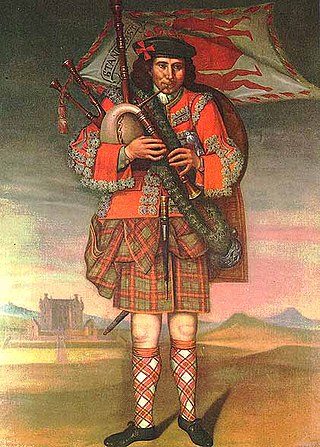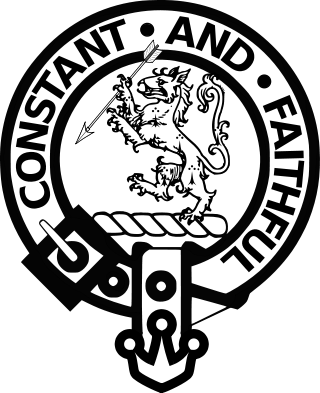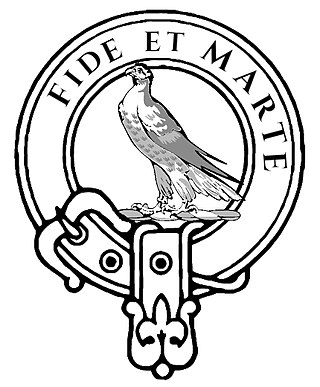
A kilt is a garment resembling a wrap-around knee-length skirt, made of twill-woven worsted wool with heavy pleats at the sides and back and traditionally a tartan pattern. Originating in the Scottish Highland dress for men, it is first recorded in 16th century as the great kilt, a full-length garment whose upper half could be worn as a cloak. The small kilt or modern kilt emerged in the 18th century, and is essentially the bottom half of the great kilt. Since the 19th century, it has become associated with the wider culture of Scotland, and more broadly with Gaelic or Celtic heritage.

A Scottish clan is a kinship group among the Scottish people. Clans give a sense of shared identity and descent to members, and in modern times have an official structure recognised by the Court of the Lord Lyon, which regulates Scottish heraldry and coats of arms. Most clans have their own tartan patterns, usually dating from the 19th century, which members may incorporate into kilts or other clothing.

Tartan is a patterned cloth consisting of criss-crossed, horizontal and vertical bands in multiple colours, forming simple or complex rectangular patterns. Tartans originated in woven wool, but now they are made in other materials. Tartan is particularly associated with Scotland, and Scottish kilts almost always have tartan patterns. The earliest surviving samples of tartan-style cloth are around 3,000 years old and were discovered in Xinjiang, China.

Highland dress is the traditional, regional dress of the Highlands and Isles of Scotland. It is often characterised by tartan. Specific designs of shirt, jacket, bodice and headwear may also be worn along with clan badges and other devices indicating family and heritage.

The belted plaid is a large blanket-like piece of fabric which is wrapped around the body with the material pleated or, more accurately, loosely gathered and secured at the waist by means of a belt. Typically, a portion of the belted plaid hangs down to about the knees or ankles with the rest of the material being wrapped up around the upper body in a variety of ways and pinned or otherwise secured to keep it in place.

Clan Anderson is a Scottish clan that is recognized as such by the Lord Lyon King of Arms. However, as the clan does not currently have a chief recognized by the Court of the Lord Lyon, it is therefore considered an armigerous clan. Variations of the surname are however considered septs of several other clans of the Scottish Highlands: The surname MacAndrews is considered a sept of the Clan Mackintosh and Clan Chattan, and also associated with the Clan MacDonell of Glengarry. The surnames Andrew and Andrews are considered septs of the Clan Ross.

The history of the modern kilt stretches back to at least the end of the 16th century. The kilt first appeared as the belted plaid or great kilt, a full-length garment whose upper half could be worn as a cloak draped over the shoulder, or brought up over the head as a hood. The small kilt or walking kilt did not develop until the late 17th or early 18th century, and is essentially the bottom half of the great kilt.

The Scottish Tartans Authority (STA) is a Scottish registered charity dedicated to the promotion, protection and preservation of Scotland's national cloth. Founded in 1995, the charitable purposes of the Authority are:
The personal name Duncan can be found in Scotland’s oldest records in its Gaelic form Dunchad/Donchadh/Donachie/Donnchadh and other spelling variants.

Clan Macfie is a Highlands Scottish Clan.

Kenneth W. MacDonald is a Scottish businessman, best known for his work within the Scottish tartan industry as owner of Houston Traditional Kiltmakers, Paisley. He currently serves as a Vice Chairman of the Scottish Tartans Authority and Deacon of the Incorporation of Weavers of Glasgow.

Clan Macqueen is a Highland Scottish clan and a member of the Chattan Confederation. The clan does not currently have a chief and is therefore considered an armigerous clan.

Clan MacEwen or Clan MacEwan is a Scottish clan recorded in the fifteenth century as Clan Ewen of Otter.
New South Wales is one of Australia's states, and has established several state symbols and emblems.
The symbols of Queensland represent the Australian state of Queensland and the Queensland Government. The different symbols and emblems represent both the state and the government. The official state emblems of Queensland are prescribed in the Emblems of Queensland Act 2005.
Victoria is one of Australia's states, and has established several state symbols and emblems.

Clan Innes is a Highland and Lowland Scottish clan. The clan takes its name from the lands of Innes in Moray, Scotland. The de facto chief of the clan is the Duke of Roxburghe, directly descended in the male line from the Innes Baronets, chiefs of the name.

The Scottish Register of Tartans (SRT) is Scotland's official non-ministerial department for the recording and registration of tartan designs, operating since 5 February 2009. As a governmental body, SRT is headquartered at General Register House in Edinburgh and is a division of the National Records of Scotland (NRS), formerly of the National Archives of Scotland (NAS) before its merger into NRS. SRT is the centralised agency for the recording of known historical tartans and for paid registration of new tartan designs, which must fulfill fairly stringent criteria. SRT subsumed this registration role from a variety of previous not-for-profit and commercial organisations, most now defunct. Since December 2018, the Keeper of the Scottish Register of Tartans is the head of the NRS. SRT's tartan database itself is also named the Scottish Register of Tartans. It is uncertain how large the database is, but it has absorbed records of at least 7,000 tartans from previous registries, in addition to accepting new entries from 2009 onward.

Clan Ralston is a Scottish clan. The clan is recognized as such by the Court of the Lord Lyon, but as it does not currently have a chief recognized by the Lord Lyon King of Arms it is considered an Armigerous clan.

District tartans for the Commonwealth of Australia and for each of its constituent States have been registered in the Scottish Register of Tartans (SRT). Additionally, fashion tartans covering either Australia as a whole, or its capital city, Canberra, have been registered in the SRT, as have district tartans in respect of some of Australia's local government areas.
















